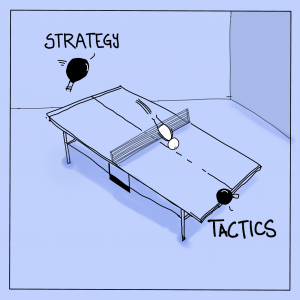
4 Factors Blocking Your Ability to Think Strategically
In 6 Critical Skills Found in Strategic Thinkers, I spoke about how strategic thinkers behave while building strategy. Roger Martin, an internationally recognized management thinker, defines Strategy in Playing to Win as:
“STRATEGY is an integrated set of choices that uniquely positions the firm in its industry so as to create sustainable advantage and superior value relative to the competition” – Playing to Win, Roger Martin.
Strategic Thinking enables you to create insights that inform decision making. It involves identifying different ways for people to attain their chosen objectives and determine what actions are needed to get them into the position they want to be in. The strategic thinker typically displays the following knowledge and behaviours identified by Professor Stephen Stumpf:
- Know The Business And Markets
- Manage Subunit Rivalry
- Find And Overcome Threats
- Stay On Strategy
- Be An Entrepreneurial Force
- Accommodate Adversity
I want to be clear that I am borrowing heavily from Stumpf’s work on strategic thinking and that much of this work references qualitative research that involved interviewing and questioning leaders. This means that I am not driving these concepts or findings at you with the idea that this is a perfect model. Instead, my goal is to provide an intro to how one might look at strategy and assess their own ability to think strategically. As I mentioned before, I have often heard CEO’s, CFO’s and COO’s (my key customers) speak about the need for more strategic thinkers on their team while simultaneously struggling to describe exactly what they mean. The idea that there are factors blocking our ability to think strategically is interesting for all of us. If only we could snap our fingers and remove the blocks we would be crafting breakout strategies that transform our personal and work lives right? The reality is that removing any of the blocks I am about to mention is difficult as some would require us switching to a new job or significantly altering the way we do our jobs that it may not be feasible. However, I believe that there are moments in our careers and lives that provide such opportunities for change so we need to take advantage of them by knowing how best to capitalize on them. The information below is again based on Stephen Stumpf’s work and it provides a checklist of possible barriers.
- YOU ARE AT THE WRONG LEVEL: Lower level supervision and management constrains our ability to think strategically as we are moving quickly to solve urgent and important problems as opposed to thinking about longer-term opportunities.
- TIME LAG: the creation of a strategy is the start and it needs to be followed by implementation and measurement. Too often, we create a strategy and implement without thinking about how long it might take to see results. This may cause us to abandon a strategy as we are unable to clearly recognize its merits or shortcomings and then quickly iterate towards success.
- LIMITS OF EDUCATIONAL EXPERIENCE: Case studies are useful for the introduction of strategic concepts but there is often difficulty translating these into action for managers. This may be due to the manager lacking the experiences necessary to translate the concept into a plan within an evolving workplace. The cases may lack the context necessary to bridge from the academic to the real-life circumstances.
- CONTEXT OF PRIOR EXPERIENCES: The need to think strategically often arises in work situations that are new to people. This means that the previous experiencing may be missing some important context for new challenges.
These 4 factors do not represent an exhaustive list of potential barriers. Instead, they serve as a starting point for you to explore your own work experience and analyze both past and future jobs. As I think about my own strategic thinking with regards to Clarity I often find myself juggling strategy and execution at different levels, in different areas across the organization. Example: I can be developing a content piece for our marketing team while responding to emails about our R&D budget before stepping into a meeting with one of my client managers. This change in levels and functions within a short period of time limits my ability to think strategically with a focus on the long term. It is important to get out of the trees so that you can see the forest, and that takes active management of my time and mindset.
The varying scope, depth and scale of anyone’s role in a growing company presents a real challenge to strategic thinking.
The ability to move quickly from execution to strategy and back becomes critical…and difficult. Let me know if you have a comment or idea on how you might make the transition between levels and functions more fluid or if you can do it at all.
